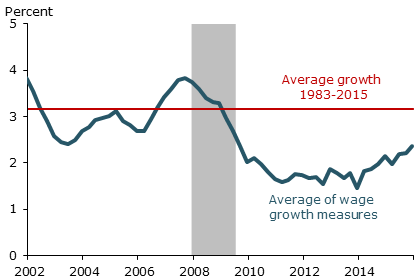While most labor market indicators point to an economy near full employment, a notable exception is the sluggish rise of wages. However, this slow wage growth likely reflects recent cyclical and secular shifts in the composition rather than a weak labor market. In particular, while higher-wage baby boomers have been retiring, lower-wage workers sidelined during the recession have been taking new full-time jobs. Together these two changes have held down measures of wage growth.

As long as employers can keep their wage bills low by replacing or expanding staff with lower-paid workers, labor cost pressures for higher price inflation could remain muted for some time.
Source: Economic Research | What’s Up with Wage Growth?, by Mary C. Daly, Bart Hobijn, and Benjamin Pyle